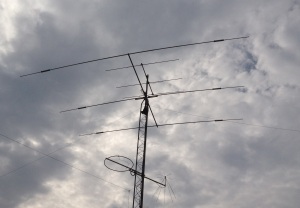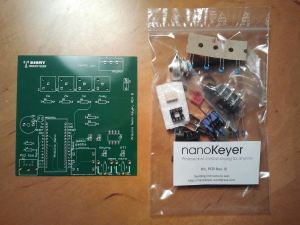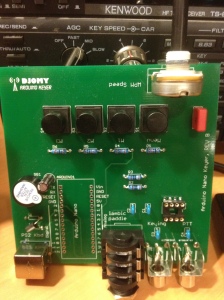Author Archive
 Elecraft Taking Orders for K10
Elecraft Taking Orders for K10
On the heels of the first KX3 shipping last week, Elecraft announced that it will begin taking orders for a new transceiver, the K10. The rig is intended to continue the Elecraft radio lineage, known for its high quality and performance. Specifications are not yet available for the rig, nor is a feature list as the rig has yet to be prototyped or designed. Several amateurs speculated that the rig will have both CW and phone capabilities and will cover all HF bands and 6 meters. More daring prognosticators predicted the rig would be 12 volt powered and have a built in antenna tuner option. Elecraft fans appear to be equally split on whether the K10 would be a kit, a real kit, or pre-assembled.
Immediately upon the announcement, eHam created a reviews area for the new transceiver and several reviews of it were posted shortly thereafter. Harold, KA3KXS, gave a glowing review noting that the rig will “probably look nicer and perform better than the overrated Yaesu FT DX 5000 or the marginal Icom IC-7800″, though he admitted to never operating either rig.
Asian markets reacted positively to the Elecraft announcement with the Nikkei index up nearly 21%. Europeans were equally enthusiastic with rallies in nearly all European markets. EU officials who have been suffering for a long time for the first time in months had a rosy economic outlook for Europe. Here in the US, both the NASDAQ and New York stock exchanges experienced furious trading, with both markets up over 37% at the closing bell. NASA recorded slight anomalies in the orbits of the moon, Venus, and Mars.
Meanwhile, Ebay was flooded with listings for new in-the-box Elecraft KX3 units, with sellers indicating that yet to be received rigs were being sold to raise money to purchase K10s. As of this writing, bids on several KX3s had exceeded list price by over 180%.
The announcement promises to make for a lively and exciting Dayton Hamvention® this year, with the ham community abuzz about the K10. Several participants have coordinated a “K10 Room” where attendees can sit on the floor and silently meditate, imagining what the rig will be like.
 My Antenna
My Antenna
My antenna…
…didn’t wake you up at 3 AM last night with loud music.
…doesn’t mind it when you leave your curtains open and walk around naked in your house.
…doesn’t rev up its engine for two hours like Joe does down the street with his old Mustang on Friday nights.
…won’t pollute your water well.
…didn’t mess up your TV yesterday, but the signal coming out of it may have. Sorry about that. I can fix that if you’ll let me.
…won’t drive up over the curb and over your flowers and shrubs.
…doesn’t belong to a gang.
…isn’t as cute as the woman next door, but my antenna didn’t call the township office like the woman next door did when you didn’t get a building permit.
…will never be on a sexual predator list.
…doesn’t bark at everything that moves.
…is a technological sculpture…well, to me, at least.
…is a gathering place for birds, when they’re not over at your bird feeder.
Come to think of it, my antenna is a pretty good neighbor.
 Fishing
Fishing
It’s been said that the universe could be described entirely with car analogies. Analogies don’t really prove anything, but they’re great for clarifying an opinion or illustrating a complex concept in a more simplified, understandable fashion. Often it’s difficult to describe amateur radio to non-technical family, friends, and co-workers.
I can’t think of a better analogy for explaining amateur radio than fishing.
Why do you call CQ and try to talk to just anyone?
We’re not out to catch one particular fish. We cast our line where we think there might be fish and when we catch one, it’s a surprise. This is part of the joy. You never quite know what you’re going to reel in.
Why do you do Morse code? Isn’t it easier to just talk to someone? Or perhaps type on your computer?
Some fisherman like to fly fish. It’s not for everyone, but it’s an art that takes a bit of practice and skill. You don’t catch bigger fish fly fishing, and many times it’s a lot more work. But some people find it more fun than regular fishing. Some do both regular fishing and fly fishing. Some fisherman ice fish.
Some hams use power amplifiers to make big signals while others use low power, this thing called QRP. Why wouldn’t everyone want to use more power?
I know guys who go deep sea fishing and catch big tuna or swordfish on big expensive boats. Some of us like to use ultralight rods and fish streams for trout or small ponds for panfish.
In this age of the Internet where you can chat with anyone around the world on your computer, why even bother with amateur radio?
Why bother buying a fishing license and all that equipment when you can much more easily go to a supermarket and buy a fish? It’s because it’s not about just eating a fish. It’s the experience of fishing.
Amateur radio seems inherently non-competitive, but you have contests?
On the surface fishing is a non-competitive hobby. But there are fishing tournaments in which fisherman compete. Like other types of fishing it’s not for everyone, but some love it, and for some fisherman that’s all they do.
What do you talk about?
We often talk about fishing techniques or what else we caught that day, but more often we talk about whatever comes to mind. Sometime we don’t talk about much at all.
Is amateur radio all old guys?
There are a lot of old guys who fish probably because they have a lot more free time, but everyone fishes. It’s nice to get the whole family fishing.
Are you always going to be a radio amateur?
You’re always a fisherman, even if you haven’t gone out fishing for awhile. I hope to fish until the day I die….
 HRD
HRD
HRD Software, LLC has released version 5.11a of Ham Radio Deluxe, the first version since their acquisition of HRD from Simon Brown, HB9DRV. The release appears to be a minor update with the most notable changes being cosmetic updates to splash screens, showing the new ownership of the product.
As many predicted at the time of the acquisition, the next version of HRD, 6.0, will be a pay-only product. The 5.x version will continue to be free and will have bug fixes released for an unidentified amount of time. Version 6.0 will be released at the Dayton Hamvention, but customers can receive a $20 discount for the product by subscribing to HRD support for $59.95 prior to Dayton. At Dayton and afterwards the price for 6.0 will be $79.95. That is a one year subscription. Subsequent support subscription renewals are $39.95 for two years of support. The software doesn’t expire and can continue to be used after support expiration, however users must have a subscription in order to get software updates.
Personally I think Ham Radio Deluxe is worth this price. As I’ve mentioned in previous posts, I think it’s the best amateur radio logging software ever written (though in a sea of outdated and badly designed sophomoric applications, the bar is often set low). But considering how good version 5.x is, it may take quite awhile for people to actually want or need to upgrade. Unless the trial version of 6.0 really knocks my socks off, I’m going to wait until perhaps version 6.1 or 6.2 to consider upgrading.
 Decisions
Decisions
Yesterday while I was continuing my research into new rigs, my TS-850 stopped working with a dead silent receiver. I pretty much wrote off the rig thinking it wasn’t worth the repair and I would be getting out the credit card and picking up the phone to place an order for its replacement. But my good friend K3PH happened to see my rig death announcement on Facebook and posted a link to a Kenwood service bulletin about a known issue with Kenwood 850 receivers going dead. For giggles I opened up the rig and checked the “RXB” voltage point, and sure enough it had the symptoms of the issue. I replaced one culprit SMT diode with two run-of-the-mill 1N914 diodes and the rig came back to life. As if that wasn’t enough, the CW QSK is now much better, with full break actually much quieter and smoother than before. It’s like the rig has a second lease on life.
So for now the decision that seemed eminent is postponed while I enjoy my reborn Kenwood 850. I’m still mulling over the choices for a new rig, but I think I have it down to the Kenwood TS-590 and the Yaesu FT-950. Despite my initial thoughts of abandoning Kenwood altogether, the 590 seems to have some of the old Kenwood flair I liked years ago. I’ve ruled out the K3, KX3, and Ten Tec Jupiter. The Ten Tec Eagle is getting pushed out of the race. I haven’t seriously considered Icom, but perhaps I should take the extra time to look at them.
So far the Kenwood and Yaesu offerings are neck-and-neck in the race, though from review comments, going through the manuals, and my experiences with other Yaesu products, I get the feeling the Kenwood interface may be more user friendly than the Yaesu menus. I do like the front CW key jack, the separate RCA REC and PTT jacks, and the rotator integration feature in the Yaesu. I wish I had an amateur radio store nearby I could touch each of these rigs.
Last night I operated during the CQ 160 phone contest with the 850. I ran 100 watts to an inverted L with a meager seven or eight short radials on my acre lot, and I worked all but perhaps four or five stations in the midwest who couldn’t hear me. It was like shooting fish in a barrel and quite fun, and really speaks to what you can do with a modest antenna on 160.
 nanoKeyer
nanoKeyer
I’m pleased to report that Oscar, DJ0MY, has created an open source hardware initiative and kit offering called nanoKeyer. This project utilizes my Arduino keyer code and the Arduino Nano, a smaller cousin of the Arduino Uno, but fully software compatible.
Oscar is offering the kit at a reasonable price, but also provides Gerber files on his site for those wishing to reproduce the hardware design. The hardware kit features three memory buttons, a speed potentiometer, a PS2 Keyboard connector, and optically-isolated keying and PTT lines. The Arduino Nano module that mates with the nanoKeyer supports the K3NG keyer code command line interface and K1EL Winkey emulation via the built-in USB port. The Arduino Nano is programmed via a typical Windows, Mac, or Linux machine with free software.
This kit offers commercial / contest quality performance and features in an open source package that can easily be assembled by beginners or customized by advanced experimenters.
 Choices
Choices
Lately I’ve been thinking (again) about getting a new rig and replacing an older Kenwood. I’ve actually cleaned up the shack a bit and have removed some little monoband rigs that I rarely use and have gotten down to the basics of just what I need. I feel I need something new in the shack, I’m just not sure what.
The Elecraft K3 would be a no brainer choice. While it’s a great rig, it somewhat has the makings of a fad for me, and I’ve never been a trend follower.
The KX3 is another option. I kind of like the idea of a portable rig that has the potential for being a primary home shack rig at 100 watts. But I still have concerns about the form factor, with the rig being so small and for portable backpack use it seems a bit fragile. I don’t know if I could be satisfied with it as a home base rig.
I would love to try a Flexradio, however each day I’m leaning more towards Mac in the shack (gasps from the audience). The last time I looked at Flex they still weren’t supporting Vista or Windows 7. Perhaps that’s changed but support for OSX is likely light years away.
Nothing that Kenwood currently offers excites me. Unfortunately I doubt I’ll ever buy a Kenwood HF rig again.
Maybe I should go with a Yaesu rig? The FT-950 looks like a reasonable choice, though a bit uninspiring. The price is right and it gets good reviews. It appears to be a good performing rig without needless extravagance like multi-kilobuck contester rigs. I’m quite pleased and familiar with the FT-817 and FT-897, so this rig would not be difficult to assimilate into the shack, though it doesn’t really get me into uncharted territory and it seems like a “safe” choice.
Perhaps it’s time I tried a Ten Tec? The Ten Tec Jupiter is kind of spartan-looking, but interesting. I like the clean look and under the hood it seems to have a lot of technology and power. One downside I see is that the MARS mod is not readily available. I modify all my rigs for DC to daylight transmit for emergency use and so I can use them as signal generators. I’ve never used a Ten Tec but I know they are legendary performers.
I’ve used Icoms and I can’t say anything bad about them, they’ve just never been on my radar. I’m not sure why.
Any thoughts from the studio audience on what’s a good $1K – $2K HF-6m rig these days?















